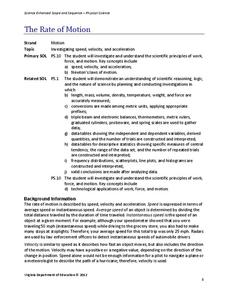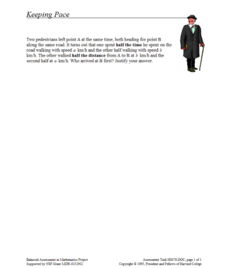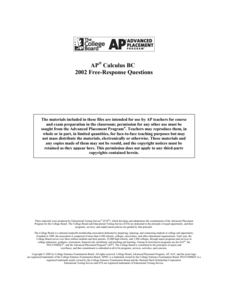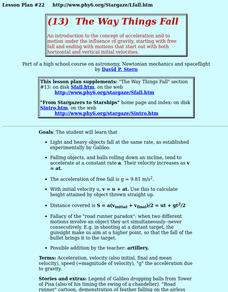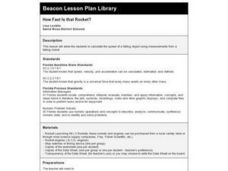Curated OER
A Classical & Relativistic Trip to a Black Hole
Students calculate distance, velocity, acceleration and time on their fantasy trip to the black hold. They apply Newton's Laws of Motion and calculate circular motion. They discuss any questions that may arise.
Curated OER
IPC Physics Final Review
In this physics review worksheet, students compare experimental variable, simple machines, and Newton's Laws. Students calculate kinetic energy, work, power, speed, and velocity. Students review conduction, convection, and radiation....
NASA
Egg Drop Lander
You have to crack a few eggs to make a good engineer! Working in small groups, young scholars design, build, and test devices that protect an egg from breaking when dropped from a ladder.
Virginia Department of Education
The Rate of Motion
How much time does it take to jump over three balloons? Pupils calculate the speed of tasks that require different motions. They determine motions for tasks such as walking, skipping, hopping, and jumping before creating a spreadsheet...
University of Florida
Understanding Car Crashes: It's Basic Physics!
Make an impact on young physicists with this fun collection of resources. After first watching a video and taking notes on the physics of car crashes, students go on to complete a series of activities that explore the concepts of energy,...
CK-12 Foundation
Oscillations Simulation
What makes a swing go back and forth like a pendulum rather than going all the way around? Scholars use the simulation to explore pendulums and how they work. They vary the weight, length of the rope, and even gravity in various trials.
Physics Classroom
Graph That Motion
Pupils apply their knowledge of the shape and slope of graphs to interpret the motion of an object. Three levels of difficulty provide plenty of practice with support thanks to the "Help Me!" button offered with each question.
Concord Consortium
Keeping Pace
What came first, pedestrian one or pedestrian two? Scholars consider a problem scenario in which two people walk at different rates at different times. They must decide who reaches a checkpoint first. Their answers are likely to surprise...
College Board
2018 AP® Physics 1: Algebra-Based Free-Response Questions
Whether determining orbitals of space craft or designing experiments with conductive dough, many young scientists discover physics is phun and attempt the AP exam to get college credit. Use the free response questions from the 2018...
College Board
2001 AP® Calculus BC Free-Response Questions
Take an abbreviated look at the exam. Class members review released items to prepare for the BC exam. The released questions are the six free-response questions from the 2001 exam. Three of the items have context, while the other three...
College Board
2002 AP® Calculus BC Free-Response Questions
Where do the questions come from? Individuals examine released items and see the topics included. Teachers use the materials to see the distribution between strictly BC content and that which is shared with AB. The 2002 Calculus BC is...
College Board
2008 AP® Calculus BC Free-Response Questions
The AP® exam is not just about the calculations. By reviewing the free-response questions from 2008, teachers and pupils see that several items require justifications and explanations to gain full credit. The chief reader even points out...
College Board
2005 AP® Calculus BC Free-Response Questions
Differentiate between the exams. Using the Q&A document, teachers compare the free-response questions that BC test-takers see to those that AB test-takers see. The pupils see which questions come from AB content and also those that...
College Board
2006 AP® Calculus AB Free-Response Questions Form B
An exam divides the six free-response questions into calculator use and no calculator use items. The non-calculator items are conceptual in nature and test whether pupils understand the calculus concepts. Scholars explain their answers...
College Board
2007 AP® Calculus AB Free-Response Questions Form B
What do the questions look like? Six free-response questions provide pupils with knowledge of how calculus topics appear on the AP® Calculus exam. The questions involve calculator and non-calculator problems by providing mathematical and...
College Board
2010 AP® Calculus AB Free-Response Questions Form B
Most say that practice makes perfect. Scholars use the released free-response questions to practice for the AP® Calculus AB exam. Each question comes with several parts and either do or do not allow calculators. Items include topics such...
College Board
2010 AP® Calculus BC Free-Response Questions Form B
Keep moving along a curve. Two items in the set of released free-response questions from the 2010 AP® Calculus BC exam involve movement along a graph. One involves particle motion along a polar curve while the other uses a squirrel...
College Board
2007 AP® Calculus BC Free-Response Questions Form B
There is just a single real-world problem. Released free-response items from the 2007 AP® Calculus BC Form B contains only one real-world question. The question involves rate of change of wind chill scenario. The mathematical problems...
College Board
2008 AP® Calculus BC Free-Response Questions Form B
This is integral to the test. Pupils realize that every question in the released free-response items from the 2008 AP® Calculus exam Form B requires integration. By reviewing the additional resources, scholars learn how important it is...
College Board
2004 AP® Calculus BC Free-Response Questions Form B
Take another look at the exam. A set of questions is a different form for the 2004 AP® Calculus BC free-response question section. The questions are evenly split into calculator and non-calculator sections. Pupils use their knowledge of...
Flipped Math
Calculus AB/BC Unit 4 Review: Analytical Applications of Differentiation
It's nice to know that there are actual real-world uses of derivatives. Scholars review their knowledge of the applications of derivatives from the unit. They work on a set of practice problems to test their understanding.
Flipped Math
Calculus AB/BC Unit 5 Review: Analytical Applications of Differentiation
Time to put it all together in one sheet—well five. Pupils review all the topics presented in the resources for Analytical Applications of Differentiation. The five pages summarize the concepts with explanations and examples.
Curated OER
The Way Things Fall
Students see that light and heavy objects fall at the same rate, as established experimentally by Galileo. They see that falling objects, and balls rolling down an incline, tend to accelerate at a constant rate a. Their velocity...
Curated OER
How Fast Is that Rocket?
Eighth graders calculate the speed of a falling object using measurements from a falling rocket. They report data from their data sheet to the teacher to record on the board or on the overhead transparency and discuss the results with...
Other popular searches
- Speed Velocity Acceleration
- Velocity and Acceleration
- Velocity Acceleration Lab
- Velocity Acceleration
- Speed, Velocity, Acceleration
- Velocity Acceleration Force
- Physics Velocity Acceleration
- Velocity Acceleration Graph
- Motion Velocity Acceleration
- Speed/ Velocity/ Acceleration
- Velocity Acceleration Momentum
- Velocity & Acceleration





